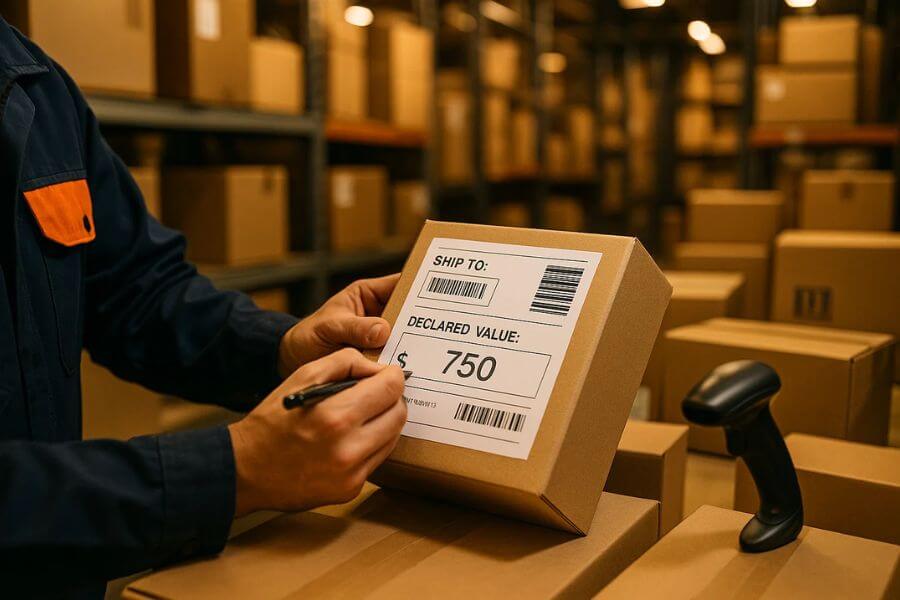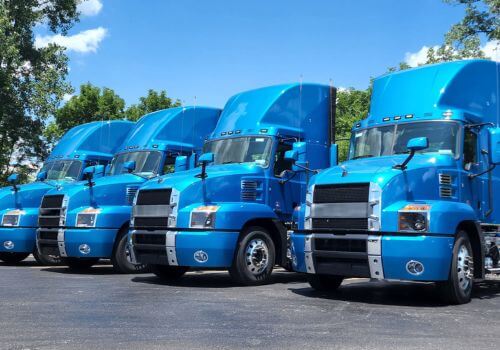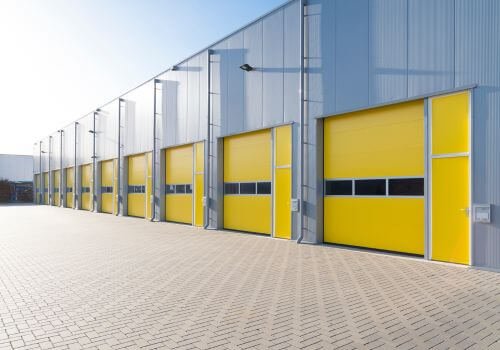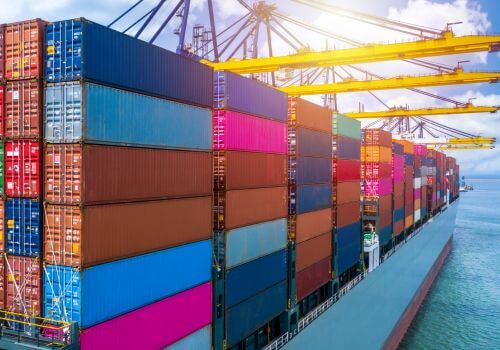In logistics, every shipment carries not only physical goods but also a financial worth that needs to be clearly identified. This is where declared value comes into play. Declared value is more than just a box you tick or a number you write on a shipping label; it’s a key factor that affects your shipping costs, carrier liability, customs processing, and ultimately your business’s risk exposure.
When you don’t fully understand declared value, you risk under-protecting your shipments, overpaying for shipping, or running into customs complications. For instance, imagine shipping $15,000 worth of industrial machinery overseas but only declaring it as $5,000. While you might save on certain costs upfront, you could face significant losses if the shipment is damaged or lost.
This guide provides a deep dive into what declared value means, how it differs from shipping insurance, the rules carriers apply, and the best practices for using it effectively.
What is declared value in logistics?
Declared value refers to the monetary worth a shipper assigns to a shipment when handing it over to a carrier. It’s essentially a statement of how much the shipment is worth for the purposes of determining liability if something happens to it during transit.
This value is important because it dictates how much a carrier will compensate you if your goods are lost, stolen, or damaged. The higher the declared value, the higher the carrier’s potential payout, but also, often, the higher your shipping cost.
For example:
- You ship 200 luxury watches valued at $20,000. If you declare the value as $20,000, the carrier is potentially liable for that amount.
- If you declare only $10,000, that’s the maximum you can claim, even if the actual market value is twice as much.
This declared amount is not the same as the purchase price or resale value; it should reflect the replacement cost, including manufacturing or procurement expenses.
What is the difference between declared value and shipping insurance?
One of the most common misconceptions in logistics is confusing declared value with shipping insurance. While both deal with protecting the financial worth of a shipment, they serve different purposes:
- Declared value: Sets the maximum amount a carrier is liable to pay if a shipment is lost or damaged. This liability coverage is usually included in the shipping fee up to a set limit, but declaring a higher value can increase your costs.
- Shipping insurance: A separate coverage offered either by the carrier or a third-party provider that can cover the full value of the goods, even beyond the carrier’s liability limits.
Example scenario:
If you ship $50,000 worth of medical equipment with a declared value of $10,000 and it’s completely destroyed, the carrier will only compensate you up to $10,000 (minus any applicable deductions). However, if you had shipping insurance for the full $50,000, you could be reimbursed for the total loss.
The key takeaway is that the declared value affects carrier liability; shipping insurance ensures full recovery of your shipment’s worth. In many cases, using both provides the best protection.
Why is declared value important in the logistics industry?
The declared value of a shipment impacts several critical areas:
- Financial protection: Accurately declaring value ensures you are fairly compensated in case of loss or damage. Without it, carriers may only pay their minimal default liability, which might be far less than your shipment’s actual value.
- Customs compliance: In international shipping, declared value plays a role in calculating import duties, taxes, and VAT. Inaccurate values can cause customs delays, fines, or even shipment confiscation.
- Customer trust: For businesses that handle high-value or fragile goods, correctly declaring value shows professionalism and care, enhancing customer confidence.
- Cost management: Carriers often charge extra for higher declared values. Understanding these costs helps you make informed decisions about balancing risk and shipping expenses.
In short, declared value isn’t just a bureaucratic requirement; it’s a strategic decision that affects the financial safety and efficiency of your logistics operations.
How do carriers calculate liability based on declared value?
Carriers have specific rules for calculating liability, and these rules vary widely between service providers.
- Default liability: Many carriers include a basic level of liability, often around $100 per shipment, without additional charge.
- Declared value surcharge: If you declare a higher value, carriers typically apply an extra fee, calculated per $100 or $1,000 of declared value above the default coverage.
- Weight vs. value rules: In freight shipping, liability might be based on the weight of the shipment unless a higher declared value is stated.
- Maximum caps: Even with a declared value, carriers may impose an absolute maximum payout, such as $50,000 per shipment.
Example with UPS:
If you ship $5,000 worth of goods and UPS’s rate is $1.05 per $100 of declared value beyond the first $100:
- Declared amount beyond $100 = $4,900
- $4,900 ÷ $100 = 49 units
- 49 × $1.05 = $51.45 surcharge
Knowing these rules helps you balance the cost of declaring value with the actual risk you’re willing to take.
Declared value in domestic vs. international shipping
Declared value works differently in domestic and international contexts:
Domestic shipping
- Primarily used to determine carrier liability and applicable surcharges.
- Customs is not involved, so the declared value is not used for tax purposes.
- Useful for ensuring claims match the shipment’s worth.
International shipping
- Declared value is critical for customs clearance, duties, and taxes.
- It must match your commercial invoice and other documentation exactly to avoid suspicion.
- Discrepancies can result in customs delays or shipment seizure.
For example, shipping $25,000 worth of machinery from the U.S. to Germany will require that your declared value matches your invoice. German customs will use that value to calculate import duties, VAT, and other charges.
Declared value and customs duties
In cross-border logistics, declared value plays a key role in determining how much you’ll pay in duties and taxes.
- CIF (Cost, Insurance, and Freight): Many countries use the CIF value to calculate duties. This includes the cost of the goods, shipping, and insurance.
- FOB (Free on Board): Some trade agreements use the FOB value, which includes only the cost of goods and loading.
Under-declaring the value to save on duties is risky and illegal. Customs agencies have valuation databases and can adjust your declared value if it seems too low. Penalties can include heavy fines, shipment seizure, or permanent import/export bans.
What are common mistakes when declaring value?
Shippers often make avoidable errors with declared value, including:
- Under-declaring to save money: Reduces potential compensation and risks non-compliance with customs.
- Over-declaring without documentation: Customs may flag inflated values, causing delays.
- Mismatched documentation: All paperwork must match exactly, including invoices, packing lists, and customs forms.
- Ignoring carrier limits: Declaring beyond a carrier’s liability cap provides no extra benefit.
- Not adding insurance: Relying solely on declared value for high-value shipments can leave you under-protected.
What are the best practices for setting declared value?
Setting the correct declared value for your shipments is not something to leave to guesswork. It requires an understanding of carrier rules, customs requirements, replacement costs, and risk management principles. A properly set declared value ensures you’re compensated fairly if something happens to your shipment, avoids disputes with customs, and helps you keep shipping costs in check.
Below are the five most important best practices to follow when determining your declared value, expanded with practical examples and considerations.
1. Use accurate replacement cost
Your declared value should be based on the actual cost of replacing the goods, not the retail selling price, not an estimated value, and definitely not an arbitrarily low number to save on shipping fees.
Why replacement cost matters:
- If your goods are damaged or lost, carriers calculate claims based on the declared value. If you’ve declared too low, you’ll be reimbursed for less than it costs to replace the items.
- Declaring retail value might sound like a good idea, but if you can’t provide documentation that matches that figure (like supplier invoices or production costs), carriers or customs might reject the value.
Example:
You’re shipping 500 units of custom electronic sensors from your factory to a distributor. The manufacturing cost is $15 each, but retail price is $30. If you declare $30 per unit and can’t produce proof that you paid that much for manufacturing or acquisition, your claim could be challenged. Declaring $15 per unit reflects the actual replacement cost and ensures you can replace the goods if needed.
Pro tip: Always keep invoices, manufacturing cost breakdowns, or supplier contracts on file to support your declared value in case of a claim or customs review.
2. Align with documentation
One of the most common red flags for carriers and customs officials is when the declared value on the shipping label doesn’t match the amounts listed on your commercial invoice, packing list, or customs declaration forms.
Why alignment matters:
- Customs agencies are trained to spot mismatches, and even small discrepancies can cause delays, extra inspections, or penalties.
- Carriers rely on documentation to validate claims. If your declared value differs from your invoice, you might not be paid the full amount in a loss or damage claim.
Example:
Let’s say you’re exporting $50,000 worth of industrial parts to a customer in Canada. If your invoice lists $50,000 but your declared value is $40,000, Canadian customs could question why the declared value is lower. This could trigger an inspection, which might delay delivery by days or weeks.
Pro tip: Create a checklist for your shipping team to verify that the declared value, invoice total, and customs forms all match before a shipment leaves your facility. This small step can save significant time and trouble at borders.
3. Understand carrier rules and limits
Not all carriers treat declared value the same way. Each has specific rules on maximum liability, surcharge rates, and eligibility for certain shipment types.
What to watch for:
- Default liability limits: Some carriers cover a base amount (e.g., $100) without extra charges.
- Maximum payout caps: For example, a carrier might limit declared value to $50,000 for express parcels or $1,000 for certain commodities like artwork or antiques.
- Special handling requirements: High-value shipments may require approval, additional packaging, or restricted routing.
- Rate calculation differences: Some carriers charge a flat fee for declared value above the default; others charge per $100 of value.
Example:
If you’re shipping high-end fashion worth $80,000 via FedEx, you can’t simply declare $80,000. FedEx caps liability for most international shipments at $50,000. Declaring more won’t increase your payout potential; it will only result in extra charges that provide no benefit.
Pro tip: Review carrier terms of service and declared value policies before every large shipment. If your goods exceed their maximum liability, secure additional third-party insurance to cover the gap.
4. Combine declared value with insurance
Declared value limits the carrier’s liability, but it’s not a substitute for comprehensive shipping insurance, especially for high-value, fragile, or irreplaceable goods.
Why both are important:
- Declared value ensures carriers are responsible up to a certain point.
- Shipping insurance covers losses beyond carrier liability and often includes broader coverage terms, such as protection against theft, natural disasters, and mishandling not covered by carriers.
Example:
Imagine shipping $150,000 worth of scientific lab equipment internationally. The carrier’s maximum declared value limit is $50,000. If the shipment is lost, you’d only receive that $50,000 unless you purchased an additional insurance policy for the remaining $100,000.
Pro tip: For shipments exceeding carrier caps, purchase third-party insurance from a logistics insurer like Shipsurance, Roanoke, or Marsh. This way, you’re fully protected from loss without relying solely on carrier liability.
5. Adjust declared value for market changes
The replacement cost of goods can fluctuate due to changes in raw material prices, currency exchange rates, or market demand. If you’re shipping items regularly, make sure your declared values are up to date.
Why updates matter:
- If you declare a value based on outdated costs, you might under-protect yourself.
- Currency fluctuations in international trade can make replacement costs higher or lower in different markets.
Example:
A company exporting copper wire reels might have declared $10,000 for a shipment based on last year’s copper prices. If copper prices have risen 25%, the replacement cost might now be $12,500. Failing to adjust means you could be short $2,500 in a claim settlement.
Pro tip: If you deal in commodities or goods with volatile pricing, review and update declared values quarterly or even monthly. Use current supplier quotes to guide your numbers.
Frequently asked questions about declared value
Q1: Can I change the declared value after the shipment has been sent?
A1: In most cases, no. Once the shipment is in transit, carriers lock in the declared value. Any changes would require canceling the shipment and rebooking it.
Q2: Does declared value affect delivery speed?
A2: Indirectly, yes. High-value shipments may undergo extra handling or security checks, which can slightly delay delivery, especially in international shipping.
Q3: Is declared value the same as customs value for tax purposes?
A3: Not always. While they are often the same for simplicity, customs value may include additional costs like freight and insurance depending on the trade terms used.
Q4: What happens if my declared value is lower than the actual value?
A4: You risk being undercompensated if the shipment is lost or damaged, as the carrier will only pay up to the declared amount.
Q5: Do all carriers have the same maximum declared value limit?
A5: No. Each carrier sets its own maximum limits, which may vary by service type, destination, and commodity type. Always check the carrier’s policy before shipping.
In summary, a Declared Value in logistics is the monetary worth a shipper assigns to a shipment for determining the carrier’s maximum liability in the event of loss, damage, or theft during transit.







